Fire extinguishers are a lot like an insurance policy — you don’t need one until your ass is on fire. Surprisingly, they aren’t standard equipment in modern-day automobiles.
Be that as it may, nothing is stopping you from installing one in your car. Because if and when it comes in handy, you’ll be very glad you had it.
However, the rules are a bit different if you’re involved in motorsport. Fire suppression is almost always mandated, regardless of the different types of race cars being used.
In this article, we’ll discuss what causes car fires, along with everything you need to know before buying an extinguisher for your car. We’ll conclude with a list of some of our top recommendations.
What Causes Car Fires?
Cars are incredibly complex machines that rely on moving mechanical parts, electrical circuitry, flammable fluids, and oil. Add solid combustibles like leather and fabric to that equation and what you get is a mobile fire hazard.
Considering all that, it’s surprising that a vast proportion of vehicles make it to the end of their lifecycle without ever spontaneously going up in flames.

This says a lot about how sophisticated modern-day automotive engineering has become, but that’s another topic for another day. All that said, vehicle fires aren’t uncommon.
In fact, according to statistics gathered by organizations such as NFPA, there were 173,000 automobile fires in the United States in 2020 alone.
Here are some of the most common reasons why vehicles catch fire:
- Clogged catalytic converters
- Electrical shorts
- Excessive overheating
- Faulty batteries
- Fluid leaks in the engine bay
- Fuel leaking onto headers or exhaust manifold
- Issues with heated seats or heating system
Most automobile fires are caused due to electrical problems. Toyota Prius hybrids, Ford F150s, and some Nissan SUVs are infamous examples of fire-hazard-related recalls.
There’s always a looming potential for vehicle fires, and there’s very little to be compromised if you commit to keeping an extinguisher in your car at all times.
This is especially true for modified cars with a supercharger or turbocharger; even more so for those with a meth injection system or nitrous oxide installed.
Fire Classes Explained
Not all fires are alike and the same is true for extinguisher bottles. Depending on what starts the fire and what fuel keeps it going, you’ll require a different type of extinguisher to douse the flames.
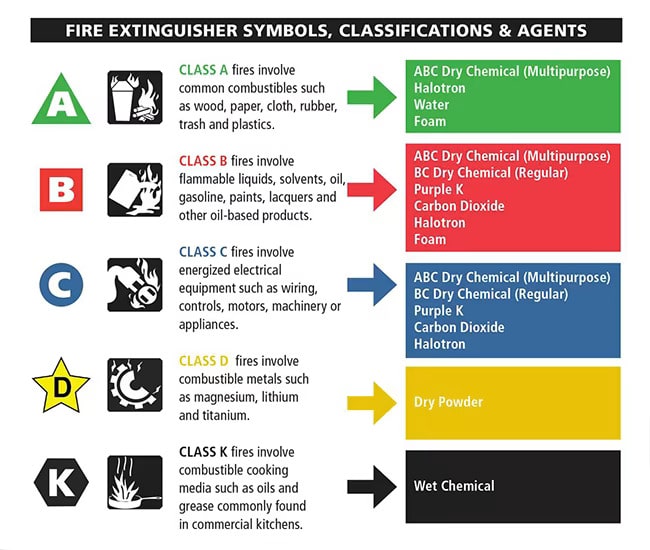
Fire is a chemical combustion reaction that typically occurs between oxygen and some form of fuel like wood, gasoline, or diesel.
For this reaction to happen, the fuel has to reach ignition temperature — the lowest temperature at which it will spontaneously ignite.
Ordinary solid combustibles such as wood, fabric, or rubber; flammable liquids and gasses; oils, and even some metals, are all fuel of some sort.
Whenever the fuel reaches its ignition temperature, a chemical reaction occurs which converts the fuel into oxygen, CO2, H2O, and some other compounds.
It’s this chemical reaction that keeps the fuel burning until it completely disintegrates. The job of a fire extinguisher is to either intercept that chemical reaction, or take away the heat, oxygen, or fuel out of the equation.
That’s why the type of fire extinguisher you use matters. Some are effective against only solid combustibles, others do a better job at putting out electrical fires, and so on.
Below we’ve discussed how fire is classified, followed by the different types of fire extinguishers.
A: Ordinary Combustibles
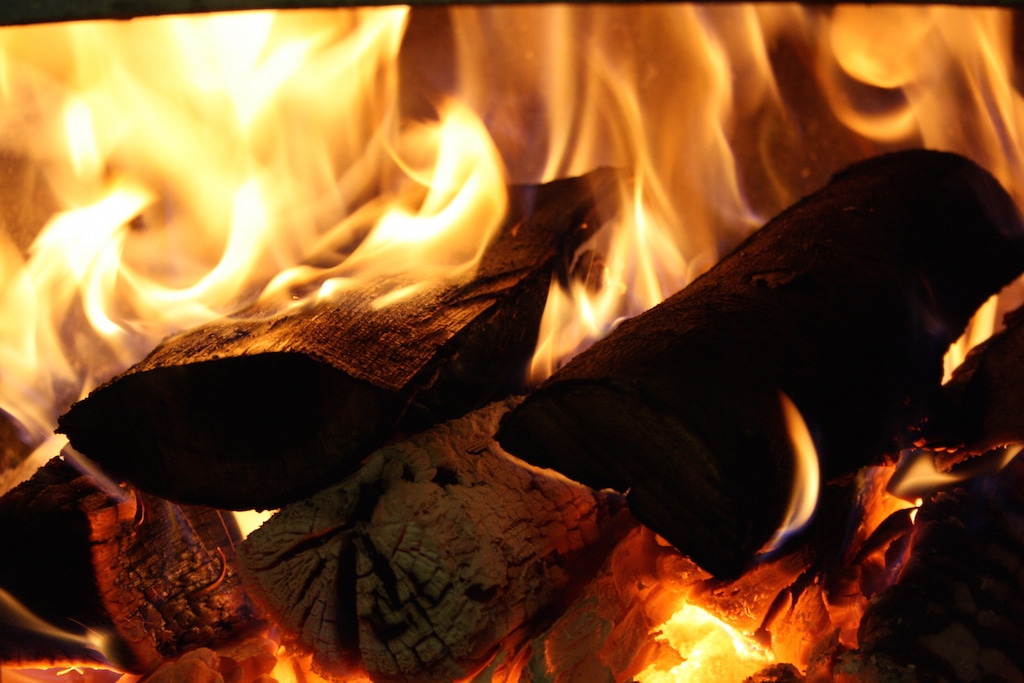
Class A fires are low-risk in the sense that they’re easy to deal with. These fires are typically caused by materials such as paper, plastics, wood, fabrics, and other solid combustibles.
Even though these are classified as low risk, they should never be taken lightly. Unlike liquid and gas fires that don’t store a lot of heat in their fuel source, solid combustibles do, and they tend to re-ignite.
These fires can be extinguished by water, wet chemical suppression, or dry chemical powder (monoammonium phosphate).
B: Flammable Liquids
If the source of the fire (fuel) involves combustible liquids such as gasoline, diesel, paint, or kerosene, then it’s considered a Class B fire. In the US, flammable gases are also included under Class B.

In Europe, the UK, Australia, and Asia, Class B only includes flammable liquids with a flash point of 212°F, whereas flammable gases in these regions are classified as C.
It’s worth mentioning that Class C in the US is different from that in the EU, UK, AU, and Asia. In America, Class C fires are electrical equipment-related.
Water should never be used to diffuse fires caused by flammable liquids because it will scatter the fuel, just as it does on grease fires.
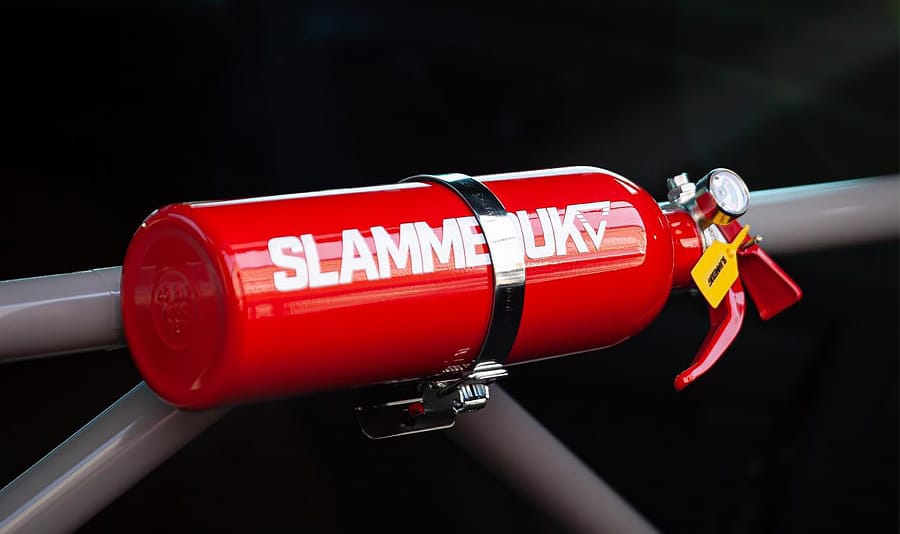
Most automotive fires are Class B, and they are best dealt with by using halogenated suppressants such as Halotron or FM-200. CO2 can also be used in this case, as well as Aqueous Film Forming Foam (AFFF).
C (EU/AU): Flammable Gases
Class C fires in Europe, Australia, and Asia are characterized by the presence of flammable gases as a primary fuel source. These include LPG, hydrogen, propane, propylene, methane, and the like.
The most effective method to suppress Class C flammable gas fires is to first cut off the fuel at its source.
If the fire is extinguished but the gas continues to leak, an explosive environment may be created, and it might reignite.
Dry chemical or powder-based (monoammonium phosphate) extinguishers are ideal for containing fires fueled by flammable gas.
C (US), E (AU): Electrical
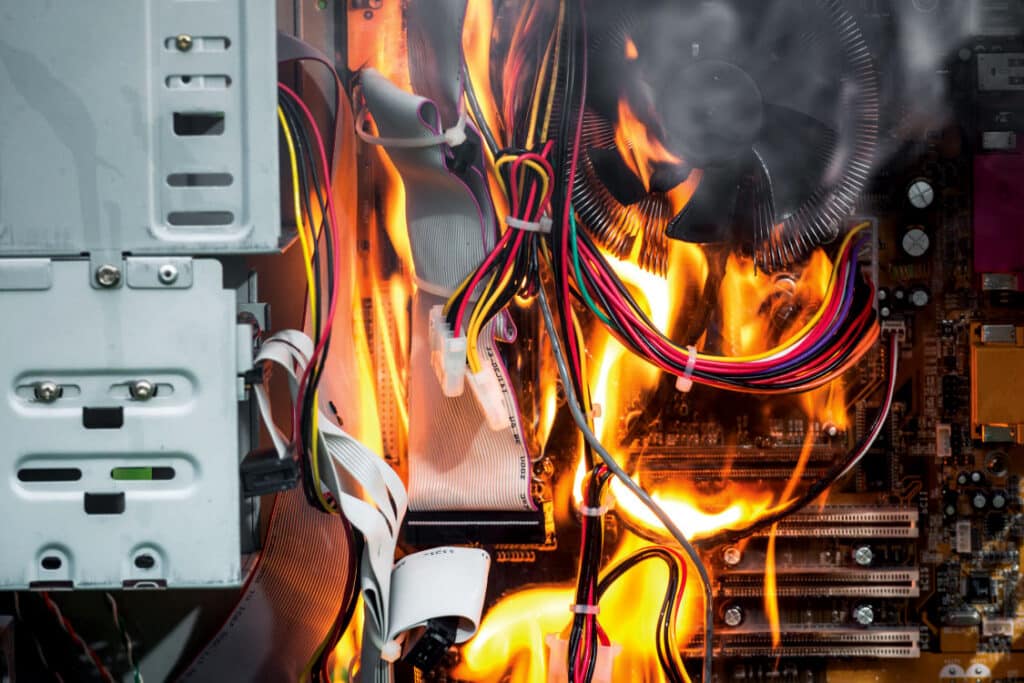
Class C fires, otherwise known as Class E, originate from electrical components. These are high-risk fires that continue to grow as long as the power source remains attached to the failing component.
They are classified as C in the US and E in Australia. In the UK, they’re classified based on the ignited fuel type which previously shared the same classification as Australia (E).
Similarly, in Europe, Class E does not officially fall into the CEN classification. Instead of the letter E, an electric spark is displayed on fire extinguishers suitable for use in electrical fires.
Never use water or foam-based extinguishers knowingly on live electrical equipment because by doing so, you run the risk of electrocuting yourself.
However, most modern water-based extinguishers are dielectrically tested. This means the contents don’t conduct any electricity, and the risk is significantly reduced.
Most water-based extinguishers that aren’t dielectrically tested have a warning along the lines of “do not use on electrical fires”.
D: Combustible Metals

Class D fires are unique in the sense that they involve combustible metals as the primary source of fuel. These metals include magnesium, lithium, titanium, and many others.
Metal fires are a hazard only if the metal is in the form of sawdust or machine shavings, and they can only be contained by smothering and heat absorption.
This can be done with the help of dry powder extinguishers, not dry chemical extinguishers. Using water will make matters worse by exciting the fire.
Different metals require different extinguishing agents. The most commonly used options include sodium chloride, graphite powder, and powdered copper.
K/F: Oil
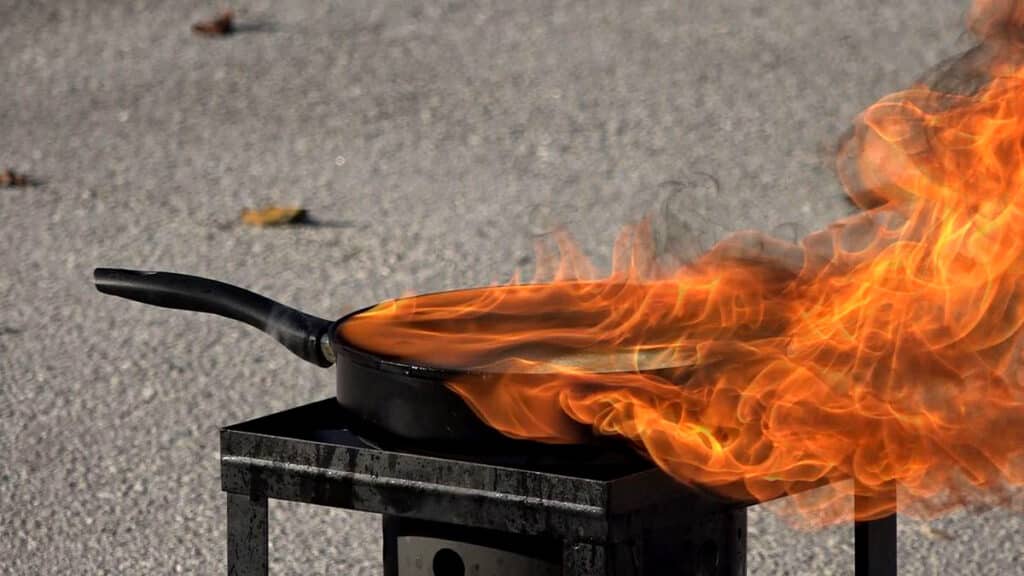
Oil fires are classified as K in the US and F in Europe and Australia. Technically, grease fires are a sub-category of the flammable liquids class.
The reason they’re recognized as a separate class altogether has to do with the higher flash point of oil compared to gasoline or propane for instance.
Water should never be used to tackle grease fires. If that’s your only option, ensure that it’s a scattered mist of water as opposed to a solid stream. The latter will scatter the fuel and exacerbate the fumes.
Halogenated suppressants, dry chemicals, and AFFF work effectively on oil-based fires.
UL Rating and Classification
Nearly all fire extinguishers manufactured by popular brands have an Underwriters Laboratory (UL) rating — a globally recognized safety standard with a focus on US-manufactured products.
This rating is denoted in the form of letters and numbers such as:
- 10B:C
- 4A80B:C
- 2A
The letters indicate fire classification, which is very straightforward. But the numbers preceding the letters mean different things for different classes.
For Class A fires, the numerical rating indicates the amount of water required to match the extinguisher’s fire-fighting capacity.
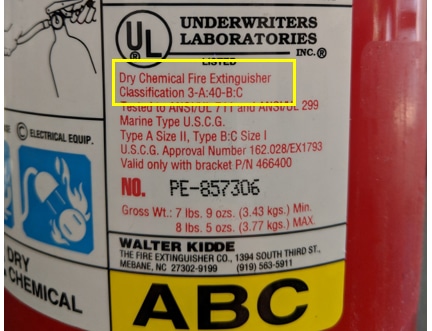
Consider 4A for example — for each unit A, the extinguisher contains the equivalent of 1.25 gallons of water. So 4A indicates “a Class A extinguisher that contains the equivalent of 1.25 gallons of water”.
This does not mean the extinguisher contains actual water, the comparison is only made to give you an idea of how capable the extinguisher is, and what intensity of fires it might be able to put out.
For Class B fires, the numerical rating indicates how many square feet of fire the extinguisher can put out.
For each unit B, the extinguisher can douse 1 sq. ft. of Class B fire. So 10B indicates “an extinguisher that can put out 10 sq. ft. of Class B fire”.
Class C extinguishers, on the other hand, do not have a numerical classification. When “C” is present in the UL rating, it indicates that the contents of the extinguisher are non-conductive, making it safe for electrical fires.
D and K extinguishers don’t have a numerical classification either. In that case, the letter simply denotes the suitable classification of fire.
Extinguisher Types and Contents
Auto fires, including EVs, are typically a combination of A, B, and C/E, but they need to be thought of as Class B fires.
Barring Foam, most extinguishing agents that can douse Class B fires can also be used against Class A and C/E.
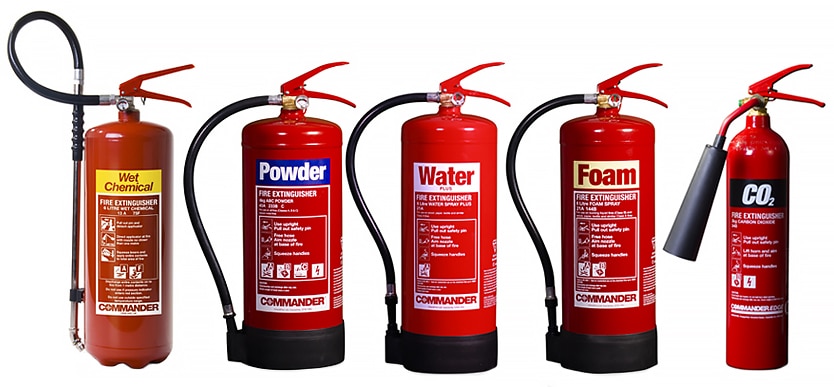
With that in mind, let’s take a look at some of the most commonly used fire extinguishing agents.
Water-Based
Water-based extinguishers are inexpensive and most effective against Class A fires. These extinguishers primarily work by removing heat, and they should not be used on electrical fires, flammable liquid fires, or grease fires.
One advantage that water-based extinguishers have is that they don’t leave a mess, unlike dry powder extinguishers or foam.
Dry Chemicals
Dry chemical extinguishers are extremely effective when it comes to interrupting the chemical reaction involving oxygen, fuel, and heat. Find some of the main substances used in these below, along with their applications.

Monoammonium Phosphate
Known as ABC dry chemical, monoammonium phosphate-based extinguishers are commonly used against Class A, B, and C fires.
It’s more corrosive than other dry chemicals listed below, is pale yellow, and leaves a residue that’s hard to clean. However, you can count on it to work on a variety of different fires.
Sodium Bicarbonate
Sodium bicarbonate, or baking soda, was one of the first dry chemical extinguishing agents developed.
When heated up, it releases plumes of carbon dioxide which is very effective at smothering fire by driving oxygen away from it.
That said, it’s not very effective against Class A fires for the following reasons:
- Solid combustibles tend to reignite easily because they store heat effectively
- Baking soda dissipates fairly quickly
Over the years, it has fallen out of favor owing to the advent of more effective dry chemicals like those listed below.
Potassium Bicarbonate: Purple-K
Purple-K was developed by the United States Naval Research Laboratory in 1959, and it is still in use at the time of writing.
It’s 5 times more effective against Class B fires than carbon dioxide and over two times more effective than baking soda and monoammonium phosphate used in ABC extinguishers.
Everyone from racecar drivers to pilots swears by Purple-K, especially when it comes to fire-fighting results.
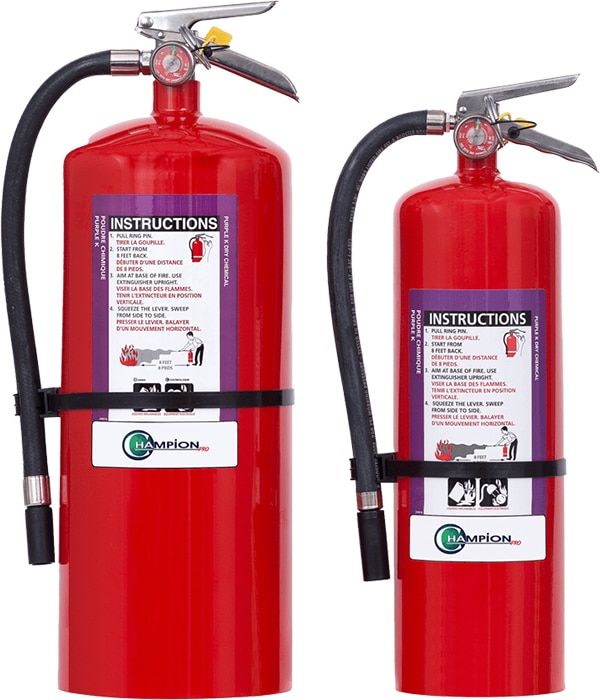
That said, many enthusiasts prefer not to use dry chemical agents on their cars because they leave an enormous mess.
It gets into the engine oil and crankcase, jams up the valve springs, and it ruins mechanical components. But that’s if they aren’t already ruined by the fire.
If you’re dealing with a minor garage fire, or if you absolutely must save your car’s mechanical components, consider using clean agents like halogenated suppressants or CO2.
You can ensure to have different types of extinguishers accessible to you, but consider that choosing the right one during an emergency or in a state of panic is easier said than done.
Class D Dry Powder
As the name suggests, Class D dry powder extinguishers are designed to handle flammable metals such as:
- Lithium,
- Magnesium,
- Potassium,
- Titanium,
- Zirconium, and more.
Class D extinguishers have no place in a car fire, regardless of whether it’s gas-powered or electric. It’s worth mentioning that lithium-ion batteries don’t contain any solid lithium metal.

That’s why lithium-battery fires are classified as B and not D. In fact, putting lithium battery fires is incredibly complex because of something called thermal runaway.
EV fires are rare, but they’re nearly impossible to put out. In fact, they can re-ignite days after being extinguished.
Compared to regular automotive fires, EV fires burn longer, hotter, and require unbelievable amounts of water to put out.
Foam
Foam fire extinguishers are a lot like water-based extinguishers in the sense that they have a cooling effect, but they don’t scatter the fuel unlike a solid stream of water can.
This is especially useful when it comes to fires involving grease and oil. Foam creates a blanket over the fuel which prevents oxygen from reaching it and reigniting the flame.
Of all the different foam-based extinguishers, aqueous film-forming foam (AFFF) extinguishers have emerged in popularity for use in motorsport.

AFFF extinguishers are non-conductive, non-corrosive, and alcohol resistant, and they clean up easily. That’s among the reasons why AFFF extinguishers are typically FIA-approved.
Other types of foam-based extinguishers include:
- Alcohol-resistant aqueous film-forming foam (AR-AFFF)
- Film-forming fluoro protein (FFFP)
- Compressed air foam system (CAFS)
Clean Agents
Clean agent-based fire extinguishers are used when there’s a need to quickly suppress fires to protect expensive performance cars, aviation control equipment, mainframe computers, and similar high-value gear.
Protecting sensitive equipment isn’t usually a priority in the event of a fire, but if it is timid enough to be taken care of easily, then it makes sense to use clean agents.
Clean agents are gaseous fire suppressants that are non-conducting and do not leave any residue upon evaporation.
These are the features you want if you want to stand a chance at protecting whatever it is you’re trying to extinguish.
“Clean agents” is an umbrella term that includes halocarbon agents, some inert gases, and carbon dioxide. These chemical compounds work by removing one or more components of the fire tetrahedron.
Halon
Up until the late 90s, halon was the gold standard in the world of fire extinguishers, and for good reason. It is 7 times heavier than CO2 and 2.5 times more effective.
It also floods more effectively by releasing in under 20 seconds when compared to an equivalent amount of CO2 which can take up to 2 minutes.
Halon has a low specific volume, which means it can compete with other clean agent extinguisher bottles that are twice the size. That way, you need fewer bottles.
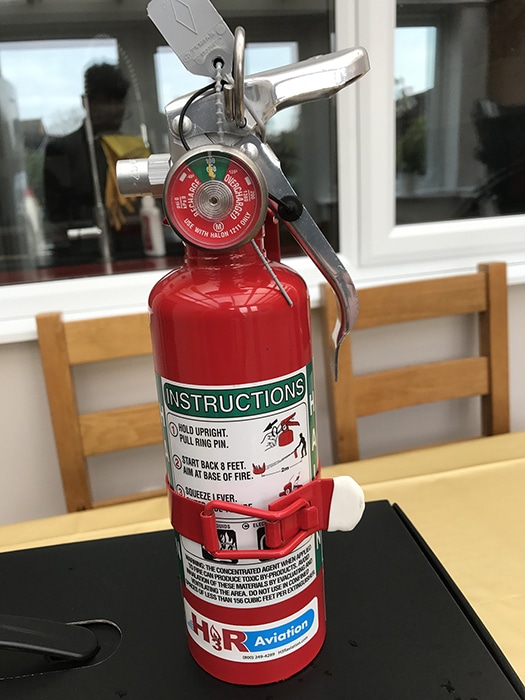
All that said, there’s one huge disadvantage — halon has the highest ozone-depleting capacity of any chemical in common use.
As a result, halons were phased out in the United States on January 1, 1994. They were also banned in Europe in 2000, and in the UK in 2003.
Even though the manufacturing of halon was outlawed in 1998, you can still legally procure recycled halon.
Sources of recycled halons include stockpiles and cylinders collected from decommissioned systems both in the United States and abroad. But bear in mind that it is a controlled substance.
Halon extinguishers with a UL Class A rating can only be used for Class A hazards and for critical applications within the military, industrial, marine, and aviation domains.
Releasing large amounts of Halon 1211 requires reporting under section 313 of the Superfund Amendment and Reauthorization Act, Title III.
Halogenated Suppressants
The next best option after Halon includes other halogenated suppressants similar to Halon 1211 and 1301, except they don’t deplete the ozone layer. Some of the most popular options include:
- Halotron I (HCFC 123)
- FE-36 DuPont (HFC-236fa)
- FM-200 (HFC-227ea)
- CO2
- Novec 1230 (Saffire Fluid)
- Potassium Aerosol Particle-Generator
- E-36 Cryotech
Auto Fire Extinguishers

With all that out of the way, you’re probably wondering “What’s the best fire extinguisher for my car?”
Let’s get down to brass tacks and take a look at some of the best automotive fire extinguishers that you can buy.
The 1st part of the list contains extinguisher bottles only. To fit these in your car, you’ll require aftermarket adapters and brackets; unless they’re included with the extinguisher. Here are a few examples:
Amerex 322

Manufacturer: Amerex
Part number: 90-322
Capacity: 5 lbs
Certification: UL 5B:C
Contains: CO2
Installation: Handheld
Actuation: Manual
Construction: Aluminum
Bracket: No (wall bracket included)
Buy on: Amazon
Amerex is the industry standard when it comes to fire extinguishers. Their 322 range is CO2-based, which is perfect if you want a zero-mess, non-conductive fire extinguisher that won’t harm the delicate components of your car.
It has a range of 3 ft to 8 ft, a discharge time of 10 seconds, and a 5B:C UL rating, which means it can put out 5 sq. ft. wide fires without causing damage to electrical components.
Amerex B479T
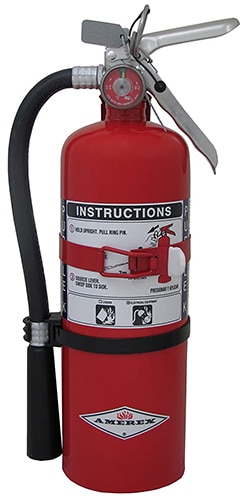
Manufacturer: Amerex
Part number: 90-B479T
Capacity: 5 lbs
Certification: UL 30B:C
Contains: Purple-K
Installation: Handheld
Actuation: Manual
Construction: Steel
Bracket: Yes
The B497T range by Amerex is a 5 lbs fire extinguisher that contains siliconized potassium bicarbonate dry chemical, better known as Purple-K. It has a range of 12 ft to 18 ft, and a discharge time of 12 seconds.
With any car fire, the main objective should be to get yourself and your passengers away from the car as safely as possible. That’s primarily what fire extinguishers are for.
If you aren’t concerned about saving the car and want the most effective extinguisher for the money, this is the one to go for. Also, trying to save a car that’s already totaled is a lost cause.
If the car catches fire due to a serious mechanical or electrical flaw, chances are that your insurance provider will cover it anyway.
Read our guides on high-performance sports car insurance and modified car insurance to learn more about the subject.
Amerex B386T

Manufacturer: Amerex
Part number: 90-B386T
Capacity: 5 lbs
Certification: UL 5B:C
Contains: HCFC-123 (Halotron)
Installation: Handheld
Actuation: Manual
Construction: Aluminum
Bracket: No
Buy on: Amazon
If you want something close to Halon but without any ozone-depleting properties, then Halotron is your best option — there’s a reason why it’s the clean agent market leader.
Amerex B386T is a Halotron-based extinguisher that discharges as a rapidly evaporating liquid that happens to be non-conductive, non-corrosive, and leaves no residue.
This extinguisher has a range of 9 ft to 15 ft and a discharge of 9 seconds. It can put out a 5 sq. ft. wide Class B fire and is safe for use on Class C fires as well.
Amerex B500

Manufacturer: Amerex
Part number: B500
Capacity: 2.5 lbs
Certification: UL 2A:10B:C
Contains: Siliconized mono ammonium phosphate (dry chemical)
Installation: Handheld
Actuation: Manual
Construction: Steel
Bracket: No (wall bracket included)
Buy on: Amazon
Model B500 by Amerex contains siliconized monoammonium phosphate dry chemical which works against both A and B fires.
It douses Class A fires by melting at 350°F and coating the surface on which it is sprayed. It fights Class B fires by breaking the chain reaction and remaining non-conductive.
Amerex B260

Manufacturer: Amerex
Part number: 90-B260
Capacity: 1.6 gal
Certification: UL 2A:K
Contains: Potassium acetate (wet chemical)
Installation: Handheld
Actuation: Manual
Construction: Steel
Bracket: No (wall bracket included)
Buy on: Amazon
Class K fire extinguishers like this one don’t typically have a place in the automotive racing world, but it’s a good idea to keep one of these in your workshop.
UL 2A:K extinguishers are ideal for putting out oil-based fires without the risk of exacerbating the flames.
Pegasus FireSense

Manufacturer: Pegasus
Part number: 2427-4.0
Capacity: 1.05 gal
Certification: FIA18, SCCA legal
Contains: AFFF
Installation: Handheld
Actuation: Manual
Construction: Steel
Bracket: No
Like the OMP Sport extinguisher, the Pegasus FireSense is part of a larger fire suppression system that can be purchased separately.
It’s an FIA-certified extinguisher that contains AFFF or aqueous film-forming foam. We recommend pairing it with one of the electric or mechanical actuation systems developed by Pegasus.
Best Fire Extinguisher for Race Cars
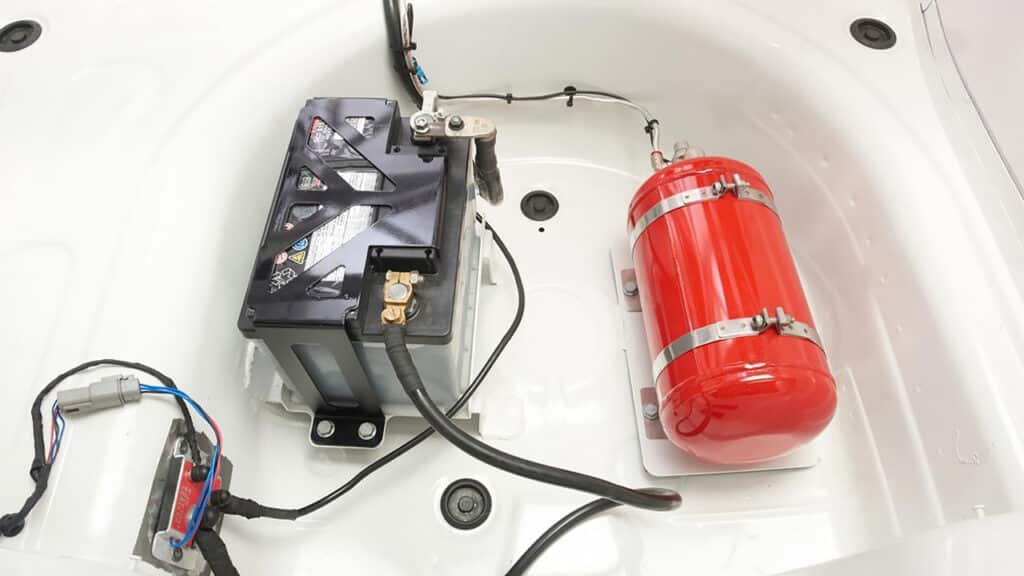
If you take racing seriously or if you’re involved in professional motorsport, then you’re going to need what’s called a plumbed-in car fire extinguisher.
In contrast to installing an extinguisher bottle in your car with the help of an aftermarket bracket, plumbed-in kits can be routed throughout the interior of your car.
With something like this, you can remotely activate the extinguisher regardless of where it is kept in the car, using a mechanical or electric actuation system. This will buy you enough time to exit the vehicle safely.
Sparco SP-425

Manufacturer: Sparco
Part number: 014772EXL
Capacity: 1.12 gal
Certification: FIA & MSA approved
Contains: AFFF
Installation: Plumbed-in
Actuation: Remote, electric
Construction: Steel
Bracket: Yes
The Sparco model SP-425 electrical kit is homologated for use in closed-cockpit saloon cars. It’s a completely plumbed-in unit that includes solid block-machined nozzles and metal connectors.
Along with that, you get an electrically operated AFFF extinguishant bottle, mounting bracket, straps, power pack, wiring harness, and an external button.
Sparco SP-425 (Mech)
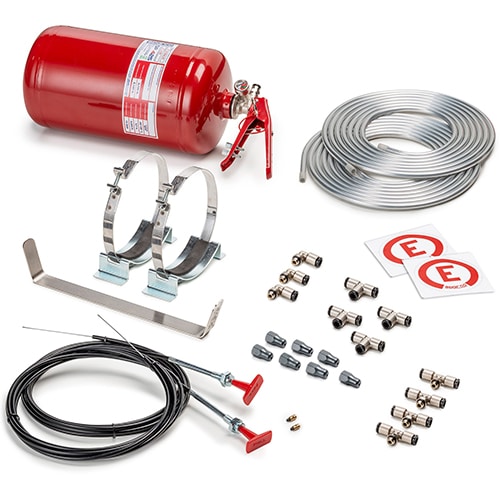
Manufacturer: Sparco
Part number: 014772MSL
Capacity: 1.12 gal
Certification: FIA & MSA approved
Contains: AFFF
Installation: Plumbed-in
Actuation: Remote, mechanical
Construction: Stainless steel
Bracket: Yes
The mechanical variant of the Sparco model SP-425 is exactly like the electrical variant mentioned above, with the exception that it’s mechanically operated.
Mechanical plumbed-in kits are arguably more reliable and cheaper, but which one you should install entirely depends on you and the regulations required in your race class.
Extinguisher Maintenance and Servicing
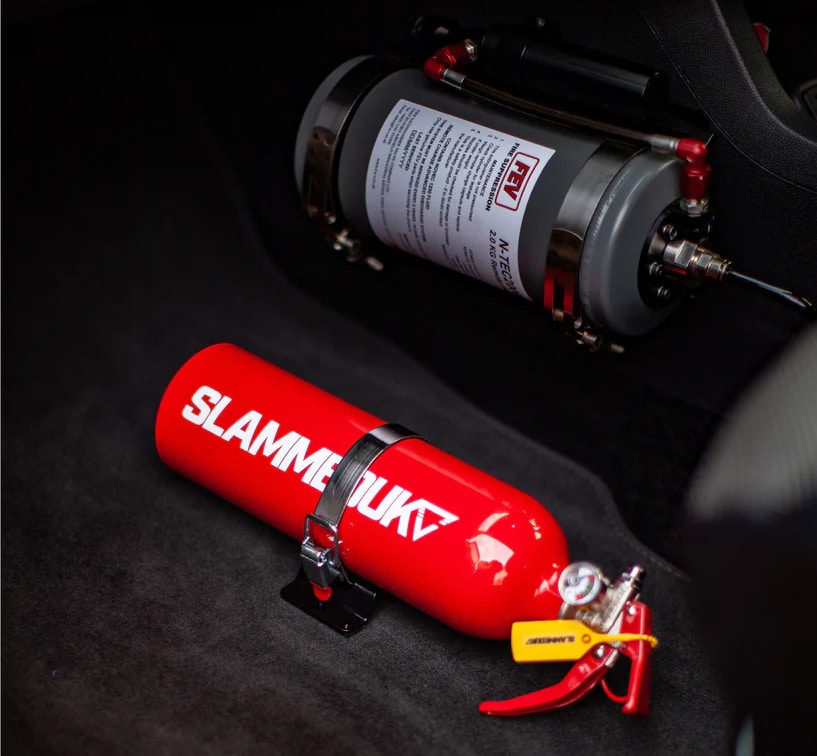
Hopefully, you never have to use your extinguisher, which brings us to the subject of maintenance and servicing.
If your extinguisher remains unused for months on end, remember to get it serviced every year, especially if you have a plumbed-in kit. Plumbing cables and nozzles need to be maintained, and bottles need to be replaced every 4 years.
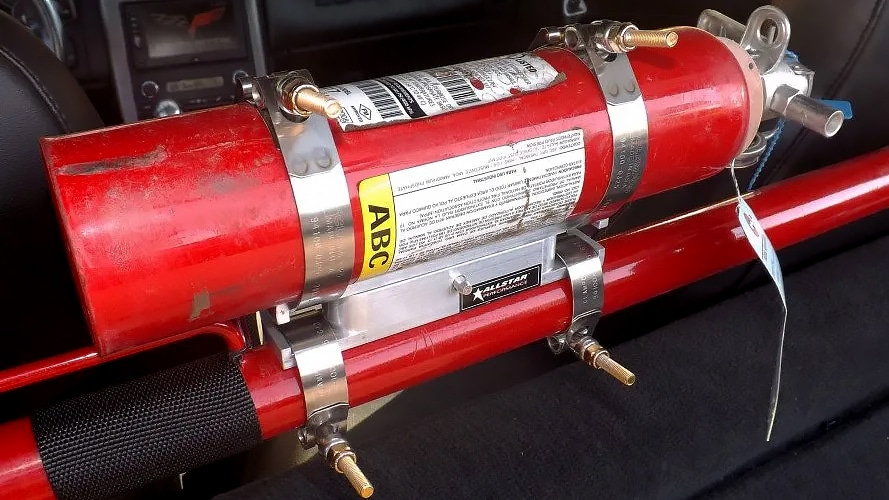
The bottles can be recertified by most extinguisher companies. The best thing you can do is to get them DOT hydrostatically pressure tested, refilled, and recertified every 5 years.
Which extinguishant would you choose? If you have experience using one of these or if you’d like to share any safety tips with the automotive community, feel free to do so by leaving a comment below.

